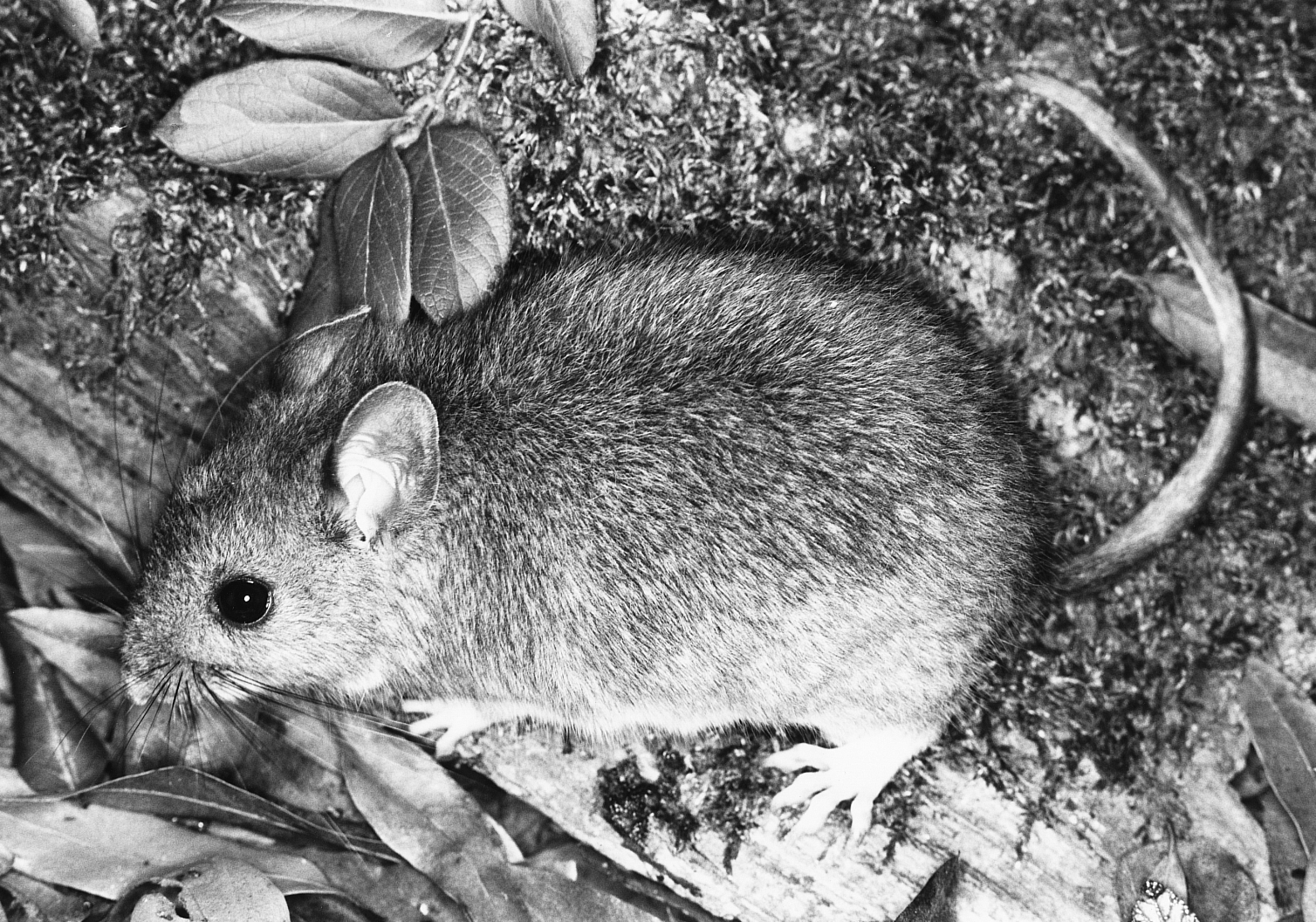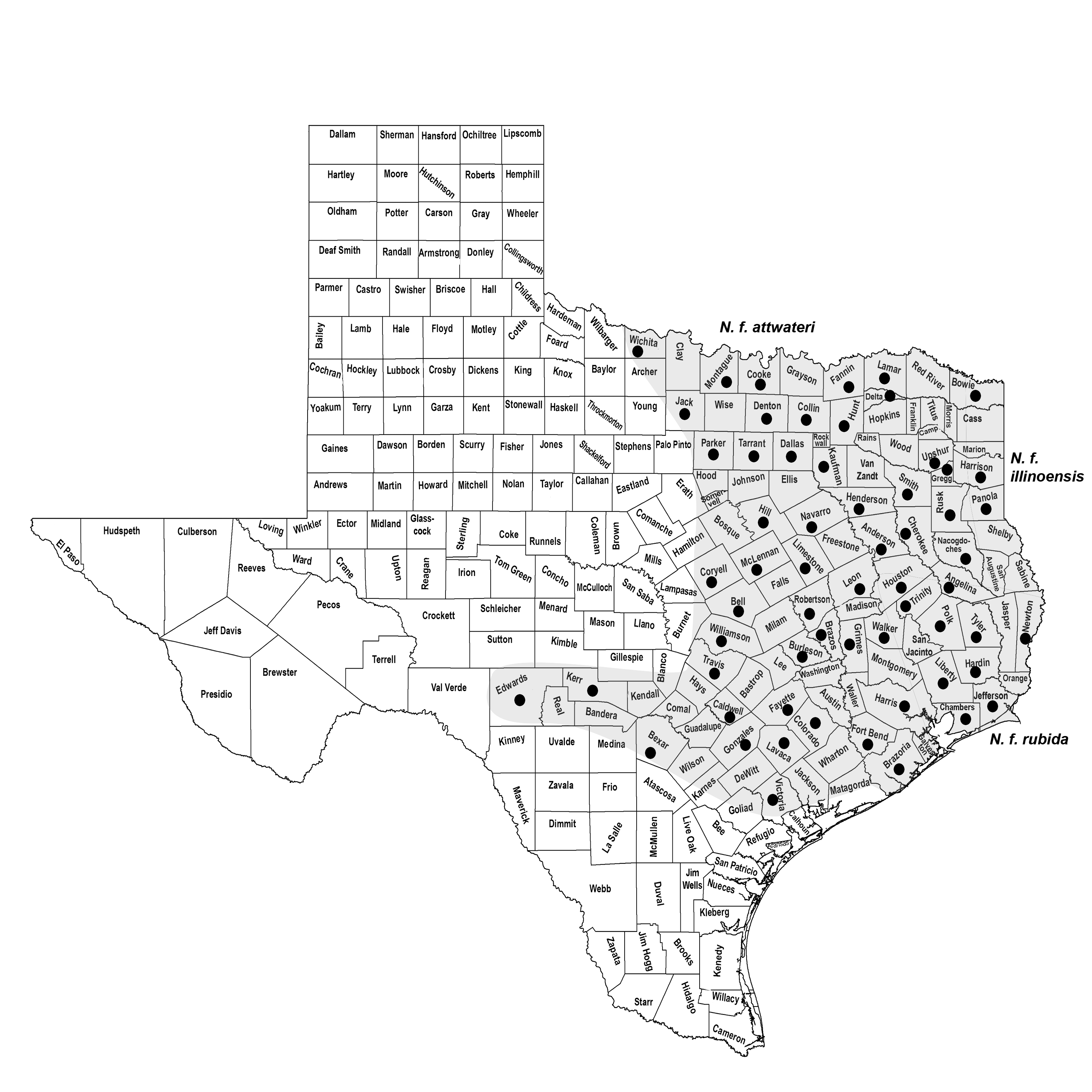EASTERN WOODRAT
Neotoma floridana (Ord 1818)
Order Rodentia : Family Cricetidae
DESCRIPTION. Large rat with long, round, tapering, scantily haired tail, large ears, and bulging black eyes. Upperparts creamy buff to buffy gray, clearest along sides; underparts and feet white; tail distinctly bicolor, white below and brownish above. Dental formula: I 1/1, C 0/0, Pm 0/0, M 3/3 × 2 = 16. Averages for external measurements: total length, 369 mm; tail, 160 mm; hind foot, 40 mm. Weight, 200–350 g.

DISTRIBUTION. Eastern one-third of Texas west to Wichita, Bell, and Edwards counties; south to Victoria County.

SUBSPECIES. Neotoma f. attwateri in the northern and western parts of the range in the state, N. f. rubida in the southeast, and N. f. illinoensis in extreme northeastern Texas.
HABITS. The wide range occupied by the eastern woodrat, encompassing habitats ranging from swamplands along the lower Mississippi River, through forested uplands, and to the arid plains of eastern Colorado, is reflected in its geographic variation and in the correlated differences in habits. In the mixed hammock and river bottom associations of eastern Texas, these woodrats do not construct surface nests but rather live in burrows at the bases of trees. This species especially is abundant in the flatland hardwood, flatland hardwood–pine, and lower slope hardwood–pine forests in the Big Thicket region of southeastern Texas. In the upland post–oak association in east-central Texas, they normally use underground burrows but occasionally resort to a combination of surface house and underground burrow or a large surface house built at the base of a tree or against a fallen log with no associated burrow. In central Texas (Edwards Plateau), they frequently live in rocky canyon walls, where they occupy mesic, upland habitats and riparian areas. These rats often utilize burrows dug by other and larger animals. In one such den in Brazos County, the large nest, located about 1 m from the entrance, was composed of dried broomsedge grasses, leaves, and small twigs.
The diet of eastern woodrats consists of varied plants, fruits, and seeds, depending in part on local availability of the food sources. In east-central Texas, they feed on acorns, yaupon berries, and the leaves of oaks, yaupon, French mulberry, greenbrier, peppervine, rattan, and hackberry. Many of these items were garnered by the rats well aboveground, which indicates that most of their foraging is done in the crowns of trees and shrubs. Gnawed bones have been found associated with their nests, and it is believed they carry bones back to their nests in order to sharpen their teeth and to obtain mineral nutrients.
The breeding season extends from January to September in Texas. Litter size ranges from one to five (average two) and up to three litters may be produced annually. The gestation period is about 33 days. Newborn woodrats are blind, deaf, and naked and weigh only 15 g. The eyes open at about 15 days of age, and weaning takes place around the 20th day. Eastern woodrats do not reach adult size until they are about 8–9 months of age, and most females do not breed until they are about 1 year old.
The home range generally is limited to the midden and immediate surrounding area. Studies suggest that 85 m (279 ft.) is an exceptional distance for them to travel in their foraging activities. Also, they are more or less colonial to the extent that several rats will establish themselves in a relatively restricted locality. In one instance, 35–50 rats lived in a 180 m (590 ft.) distance along a favorable gully.
Given that these rats usually inhabit wooded or brushy lands, they seldom come into close contact with humans; however, they may construct their middens in human structures such as barns and other outbuildings. They are preyed on by owls, skunks, foxes, and other flesh eaters.
POPULATION STATUS. Common. The eastern woodrat is common throughout its range in Texas.
CONSERVATION STATUS. The IUCN lists the eastern woodrat as a species of least concern, and it does not appear on the federal or state lists of concerned species. It does not appear to face any serious conservation threats.
REMARKS. Neotoma floridana is often difficult to distinguish from the closely related species N. micropus where they co-occur on the Edwards Plateau, and there is some evidence that the two species may hybridize with each other in that area.
From The Mammals of Texas, Seventh Edition by David J. Schmidly and Robert D. Bradley, copyright © 1994, 2004, 2016. Courtesy of the University of Texas Press.
Natural Science Research Laboratory
-
Address
Museum of Texas Tech University, 3301 4th street, Lubbock, TX 79409 -
Phone
806.742.2486 -
Email
nsrl.museum@ttu.edu

